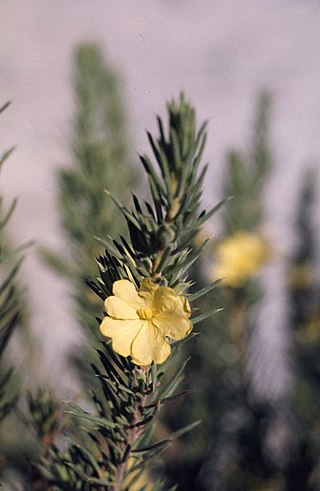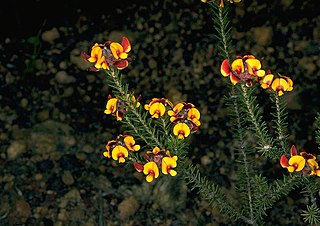
Melaleuca ciliosa is a small shrub in the myrtle family, Myrtaceae and is endemic to the south-west of Western Australia. It has bright or pale yellow flowers, an unusual calyx and leaves that are slightly hairy, especially around the edges.
Verticordia huegelii var. stylosa, commonly known as variegated featherflower, is a flowering plant in the myrtle family, Myrtaceae and is endemic to the south-west of Western Australia. It is a single-stemmed shrub with its growth form depending on its surroundings. It is similar to other varieties of the species but differs in its flower colour and the form of the style and staminodes.

Boronia oxyantha is a plant in the citrus family, Rutaceae and is endemic to a small area in the south-west of Western Australia. It is a shrub with many hairy branches, pinnate leaves and pink, four-petalled flowers that have a darker midrib.
Dillwynia divaricata is a species of flowering plant in the family Fabaceae and is endemic to the south-west of Western Australia. It is an erect, spindly shrub with cylindrical, grooved leaves and yellow flowers with brownish markings.

Dillwynia uncinata, commonly known as silky parrot-pea, is a species of flowering plant in the family Fabaceae and is endemic to southern Australia. It is an erect, spreading shrub with cylindrical leaves and yellow flowers with a red centre.
Pultenaea adunca is a species of flowering plant in the family Fabaceae and is endemic to the south of Western Australia. It is an erect, spindly shrub with hairy, needle-shaped leaves and yellow and red flowers.
Hibbertia helianthemoides is a species of flowering plant in the family Dilleniaceae and is endemic to a small area in the south-west of Western Australia. It is a prostrate to low-lying, spreading to erect, hairy shrub with hairy foliage, linear leaves and yellow flowers with thirteen stamens.
Pultenaea calycina is a species of flowering plant in the family Fabaceae and is endemic to near-coastal areas in the south of Western Australia. It is an erect, spindly shrub with flat or more or less cylindrical, grooved leaves and yellow and orange flowers.

Hibbertia mucronata is a species of flowering plant in the family Dilleniaceae and is endemic to the south of Western Australia. It is an erect shrub with hairy branches, crowded, thick, tapering linear leaves ending in a sharp point, and golden yellow flowers with five stamens fused at their bases, all on one side of two densely hairy carpels.
Bossiaea divaricata is a species of flowering plant in the family Fabaceae and is endemic to the southwest of Western Australia. It is a low, dense, openly-branched shrub with oblong to egg-shaped leaves and deep yellow and dark red flowers.
Pultenaea purpurea is a species of flowering plant in the family Fabaceae and is endemic to the south of Western Australia. It is a small prostrate shrub with cylindrical leaves and yellow-orange and red flowers.
Gompholobium obcordatum is a species of flowering plant in the family Fabaceae and is endemic to the south-west of Western Australia. It is an erect, open shrub with heart-shaped leaves, the narrower end towards the base, and uniformly yellow, pea-like flowers.
Pultenaea rotundifolia is a species of flowering plant in the family Fabaceae and is endemic to the south of Western Australia. It is a straggling, spreading shrub with flat, glabrous leaves, and yellow flowers with red markings.
Pultenaea spinulosa is a species of flowering plant in the family Fabaceae and is endemic to the south of Western Australia. It is a shrub with flat, hairy leaves, and uniformly yellow flowers.

Pultenaea verruculosa is a species of flowering plant in the family Fabaceae and is endemic to the south-west of Western Australia. It is an erect shrub with flat, hairy leaves, and yellow-orange and red, pea-like flowers.
Hibbertia verrucosa is a species of flowering plant in the family Dilleniaceae and is endemic to the south-west of Western Australia. It is a shrub with scattered, densely hairy, narrowly rectangular leaves and yellow flowers usually with ten stamens fused at the bases, all on one side of two densely softly-hairy carpels.

Lasiopetalum quinquenervium is a species of flowering plant in the family Malvaceae and is endemic to the south of Western Australia. It is an erect, spreading shrub with hairy stems and leaves, egg-shaped leaves and pink or white flowers.

Mirbelia subcordata is a species of flowering plant in the family Fabaceae and is endemic to the south-west of Western Australia. It is an erect, spreading shrub with egg-shaped to lance-shaped leaves and yellow or orange and red flowers.
Spyridium villosum is a species of flowering plant in the family Rhamnaceae and is endemic to the south-west of Western Australia. It is a small shrub with shaggy-hairy branchlets, linear to oblong leaves and dense heads of hairy flowers with broad brown bracts at the base.
Marianthus granulatus is a species of flowering plant in the family Pittosporaceae and is endemic to a restricted part of the southwest of Western Australia. It is a twining shrub or climber with often clustered, egg-shaped to heart-shaped leaves and pale blue flowers with darker blue spots and yellow streaks, arranged in groups of three to five.







